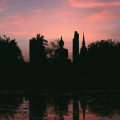SUKHOTHAI HISTORICAL PARK
At 12 km from the new town, the historical park of Sukhothai shelters the vestiges of the first Thai capital, founded in 1257, at the time when the kingdom freed itself from the Khmer supervision. Numerous monuments are still visible from this glorious era. Listed as a UNESCO World Heritage Site in 1991, some of these buildings (or what remains of them) can be seen, but it should also be noted that in the surrounding rice fields many remains are still waiting to be discovered. Some 193 ruins are present on the 70 km² site. The Ramkhamhaeng National Museum is a museum that houses the various objects discovered during the various excavations carried out.
To discover the park and its many treasures, in an atypical atmosphere, Loy Krathong is the ideal period. As in Chiang Mai, the fervour is great. You will have to take your precautions and book a hotel several months in advance. The entrance of the park is free. Markets are held on site with food stalls, drinks, craftsmen ... But above all, grandiose shows (dance, music, theatre) are given every evening in front of the monuments illuminated for the occasion. Prices vary according to the show.
Inside the fortifications. The centre of the city was surrounded by earthenware ramparts, forming a rectangle of 1,300 by 1,800 metres, with four gates. The remains of 35 structures are scattered within the fortified enclosure, the most important are:
The Royal Palace and Wat Mahathat. It is by there that the visit of the park traditionally starts. Wat Mahathat, the largest monastic temple of the ancient capital, is the symbol of this great civilization disappeared. It was the temple of a palace of which nothing remains today. The main stupa, as well as the four others surrounding it, were built in the form of a Prasat. Others are located to the south. The main chedi are decorated with lotus buds and are characteristic of the typical Sukhothai art style. It is also on the site of this palace, at Wat Si Chum, that the stone of King Rama Khamhaeng was found. It is said that he created the Thai alphabet (44 consonants, 32 vowels and 5 tones). Inscriptions from 1292 discovered at this site provide detailed accounts of the economy, religion, social organization and governance of the Sukhothai kingdom. Wat Mahathat is characterized by multiple chedi and a large 9-meter sitting Buddha. It extends over a square of 200 m side, formerly surrounded by moats. There were, at that time 185 chedi, 7 chapels and 11 viharn.
The monument in honor of King Ramkhamhaeng. In the north of Wat Mahathat, is this bronze statue of the king, sitting on a throne with at its base a bas-relief relating his life and his feats of arms.
Wat Si Sawai. Set in the middle of a beautiful landscape, west of Wat Mahathat, Wat Si Sawai has three prang, these Khmer style pagodas surrounded by a laterite wall. A sculpture of Vishnu found on the site testifies to the Hindu origin of the temple, later converted into a Buddhist monastery. It is one of the oldest of Sukhothai, it would have been built in the 12th or early 13th century.
Wat Traphang Ngoen. This temple located at the west of Wat Mahathat has a large square pedestal with statues of Buddha standing in four niches of the sanctuary. A vihara is located at the entrance. This building has suffered from the test of time and has sagged considerably.
Wat Chana Songkhram. To the north of Wat Mahathat, a large circular bell-shaped chedi, whose style is an interesting example of the fusion of Sinhalese style and Sukhothai art, constitutes the main monument of this temple.
Wat Mai. To the north of Wat Mahathat, it consists of a brick vihara in the Ayutthaya style.
Outside the fortifications
Wat Phra Phai Luang. It is located 500 m from the northern gate. It is a Khmer Hindu sanctuary surrounded by a moat and later converted into a Buddhist monastery. It is the second largest temple on the site after Wat Mahathat. Three similar prang were erected, but only the northern one is still standing today. This temple is a good example of the transition from Khmer to Thai art.
Wat Si Chun. Located 1.5 km north of Wat Mahathat, this temple was originally surrounded by a moat. A mondop (a building square at its base, cubic in shape with a pyramidal roof) 15 meters high, houses a monumental brick Buddha in the posture of taking the ground to witness. It measures 11.3 meters from knee to knee. There is a passage in the wall that leads to the top of the statue.
Wat Saphan Sin. Located west of the heart of the park, on a hill 200 meters high, this shrine is accessible by a slate staircase.
Wat Chetupon. This temple 2 kilometers west of Wat Mahathat contains a mondop housing four Buddhas in different postures: standing, sitting, lying and walking. An original feature: a small shrine is located behind, containing an image of Maitreya, the future Buddha.
Wat Chang Lom. On Jarot Withithong Road, behind The Legendha Resort, is this temple with an impressive chedi of Sinhalese origin. Its base is decorated with rows of 32 elephant sculptures.
Did you know? This review was written by our professional authors.
Members' reviews on SUKHOTHAI HISTORICAL PARK
The ratings and reviews below reflect the subjective opinions of members and not the opinion of The Little Witty.







自然の中に佇む遺跡は日本人の価値観によく合う。